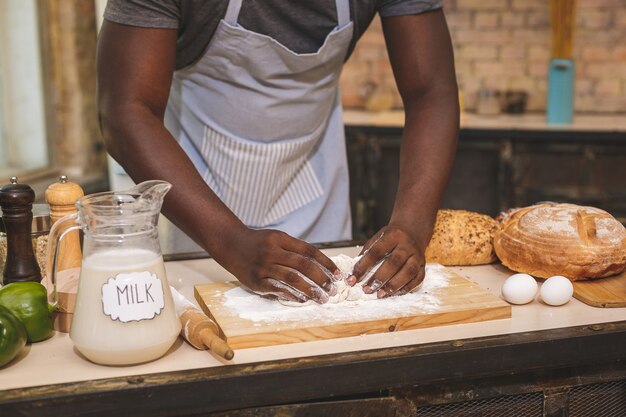
Why Bake?
How many times have you heard people say that baking is not for everyone? Me, I have always believed that anybody can bake. Male or female. Like many other indulgences in life, practice makes perfect and you have to keep trying to discover what best works for you.
There are so many reasons why you should learn how to bake at home, just the very reason why it’s good to know how to cook. While cooking is an art, baking is mainly science — the exact mixes of ingredients being combined and reacting as they’re supposed to react are chemistry.
Meditation
Baking is meditative. Because of the amount of time and focus needed in whipping up a cake, your brain is very much absorbed in the activity at hand and doesn’t have time to think about other things that might be worrying you. Your mind is entirely centered on it. Even the aroma of freshly baked bread, meat pie, or cake is enough to put your mind at ease. What could be better than having a house that smells like baking chocolate cookies or pie? The aroma isn’t only pleasant but intensely emotional.
Baking is for sharing
Baking is always a communal experience. When we make a cake, it’s often to share it with families, co-workers, or our clients. We intend to embark on cake making with the intention to share. There is always that tinge of joy when you are on a journey to put a smile on another person’s face.
Baking is creative
Researchers have found a strong connection between creative expression and overall wellbeing. Why not experiment with that recipe if you can and make that cake the prettiest it can be. Creativity is an intelligent way of having fun. The freedom to make mistakes, especially at the learning stage, is vital to creativity,
Freshness
When you bake at home, you have complete control over the ingredient quality and freshness. Your bread or cake is served freshly hot and no incident of buying an old bread or a 3-day old cake. Whether you a fan of a chocolate cake or a cake with no icing, you probably have freshness guaranteed if you bake at home.
A family who bakes together stays together
When you bake at home, there is a tendency you put the choice and taste of other members of your family into consideration. My wife bakes, real good just like me. She never sets out to design a cake without having at the back of her head that Kimberly and Onyedika (2nd and 3rd of my children) love chocolate toppings on their cake. Michelle, the eldest won’t joke with strawberry linings. In fact, this is a clear way to show your concern, care, and love for your family. When you bake, involve your kids, and see them loving the moment of it. Some of the best family time is that one spent in the kitchen. Even toddlers can help stir and cut and decorate cookies. In so doing, they would in turn learn how to bake from you and improve on it without paying one kobo to anybody. Better still, you equip your daughter/son with an experience gift that would be everlasting.
Price
Buying baked goods at the grocery store or a local bakery is always going to be a convenient way to eat.
However, if you are on a tight budget or want control over the ingredients in your food, homemade baking is the best option. At first, buying the basic cake kitchen tools or cake ingredients may present an initial problem, but I tell you, you will recoup on this investment over time. However, the 8 essential ingredients used in cake baking may readily be in your kitchen all year round. You can also learn the basic cake tools here.
The basics of Baking
In order to grasp the full understanding of baking (here baking includes baking of cookies, bread, cakes, meat pie e.t.c), it is important that we look at the basic ingredients for bakery, cake tools, cake techniques, and top tips that would make you bake like a pro. Baking is a science that relies on the understanding of the basic fundamentals of the baking process. Once you understand how each action you take affects the finished product, you will be able to replicate recipes with greater ease.
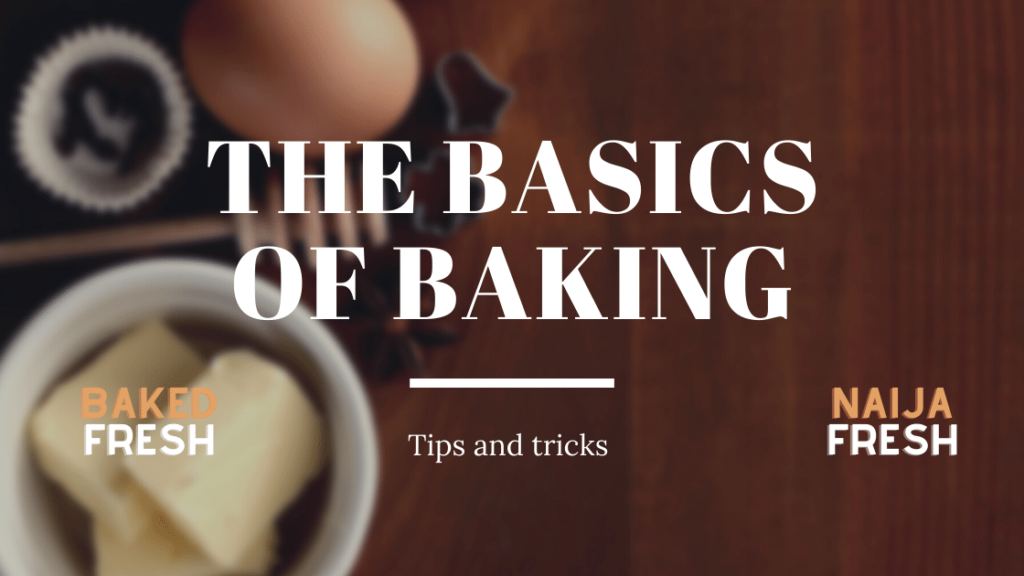
Tips and tricks
The importance of Accuracy
Baking is a science and as such, it requires that all the ingredients should be in the required ratio. This is because when your cake enters the oven, the ratio of the ingredients will hugely play a part in what your cake, bread, cookies will look like.
Your ingredient measurements have to be precise to get the chemical reactions you need and to score that perfect, consistent result every time.
Almost all baked goods are made of the same ingredients, that is, flour, water, salt, fat, and leavening agents. Sometimes the only difference between the two products is the method used to assemble the ingredients or the ratio of ingredients used in a recipe. Small changes to the method and ratio can have large effects on the quality of a baked good. Measurement in baking requires that you follow recipes exactly as written and measure the ingredients properly. For instance, a ratio of 1/2 cup of butter to 2 cups of flour (1:4) seems to work pretty well. You can read further in-depth analysis on what ratio of ingredients is best for a particular cake or bread on our measurement for cake ingredients.
Set Up Your Ingredients Before You Start
If your recipe instruction indicates that you have to sieve your flour, do that as well as measure in good time before you start to bake. In baking, as soon as you start, its process is already timed and require certain precise timing for each step. Get your eggs broken and ready including all other ingredients so that you don’t run amock during the baking time.
Adhere To Room Temperature In Baking
What does it mean by room temperature in baking?
When you are bringing ingredients to room temperature you want them to be around 70 F (21 C). This is the temperature at which butter is soft but is not starting to look greasy or glossy yet (melt).
What happens when you use butter straight from the fridge? It’ll be stiff and difficult to beat—and you will surely end up with fragments in your dough.
What happens when your butter is too soft? The answer is simple: It won’t hold air, and your cakes and cookies will come out flat.
Unless a recipe specifically calls for cold ingredients, it’s a good rule of thumb to set these ingredients out on the countertop or table 30 minutes prior to making the recipe.
Many ingredients, mainly fats, change properties with temperature. Many of these baking ingredients may be stored in the freezer prior to the baking time. Read further on how I can quickly bring my ingredients to room temperature.
Always Sift Your Dry Ingredients
Sifting is a process that breaks up any lumps in the flour and other dry ingredients and aerates it at the same time by pushing it through a gadget that is essentially a cup with a fine strainer at one end. Sifters could also be locally made mesh with a wooden or aluminum handle. Sifted flour, which is much lighter than unsifted flour, is easier to mix into other ingredients when forming a cake batter or making dough.
Apart from the above, sifting ensures that all of your individual dry ingredients come together to give a uniform mixture before you start with the batter or dough.
Lighter Crust
In baking, a crust is the outer, hard skin of bread or the shell of a pie. For a better crust, just as you put the bread or pie or cake in the oven, fill the tray with cold water. This creates a steam bath in the oven which helps the bread to have a lighter crust and prevents it from tearing.
If you need to ensure to one hundred percent that your cake isn’t sticking to the bottom of the pan, parchment paper is also advised. Parchment paper or baking paper is a grease-proof paper that is used in baking and cooking as it provides a heat-resistant, non-stick surface to bake on. There are also other methods like oiling or dusting with flour on the inner surface of the pan.
Is Your Dough Kneaded enough?
Kneading is the massaging of bread dough before baking. Kneading stretches the strands of gluten in the dough, allowing for more expansion during fermentation. Well-kneaded, elastic dough holds more air bubbles than dough that hasn’t been kneaded, and the strong gluten network keeps those bubbles in place throughout the proofing and baking processes. Kneading also breaks up gas bubbles for a consistent crumb, distributes yeast equally, and evens out the temperature of the dough, allowing for uniform proofing and baking.
To check if your dough is kneaded enough, pull out a piece of dough between your hands. It should be able to stretch up to 20cm without breaking.
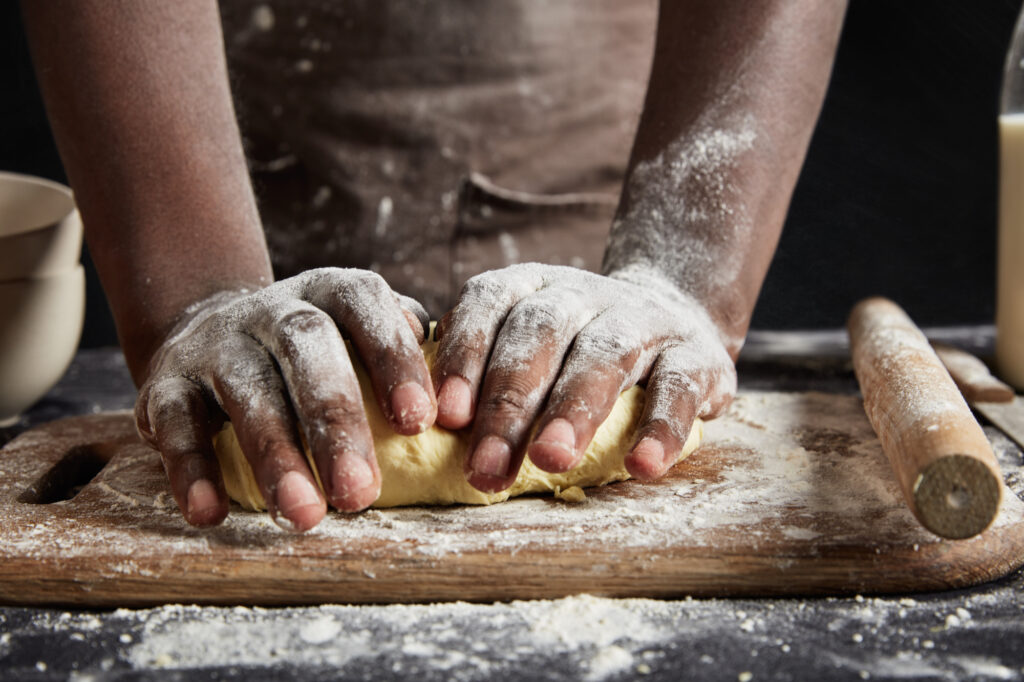
Essential baking equipment and tools
As a beginner, you need not a ton of baking equipment. There is basic baking equipment for beginners who wants to start from scratch. For better understanding, I have categorized these baking equipment under basic baking tools and cake decorating tools.
Basic baking tools
These are must-have 10 baking equipment list
- Baker’s knife
- Hand whisk
- Dry and liquid measuring spoons and cups
- Spatula
- Kitchen scale
- Metal mixing bowl
- Ice cream scoopers
- Sifter
- Stand mixer and
- Oven
I have details on the basic baking tools with their uses and pictures in a dedicated article prepared by Ifeoma, our Chief chef. You can acquaint yourself with their specific uses and their relative prices in the market compared to what Naijah Fresh sells.
Basic decorating tools
- Cake icing turntable
- Icing nozzles
- Cake mould
- Cake dummies
- Silicone brushes
- Shape cutter
- Cake stencil
- Non-stick rolling pins
- Cake smoother
To see these cake design tools and their pictures and also learn their uses in cake making, please go to Cake Design tools and their uses.
Cake Ingredients
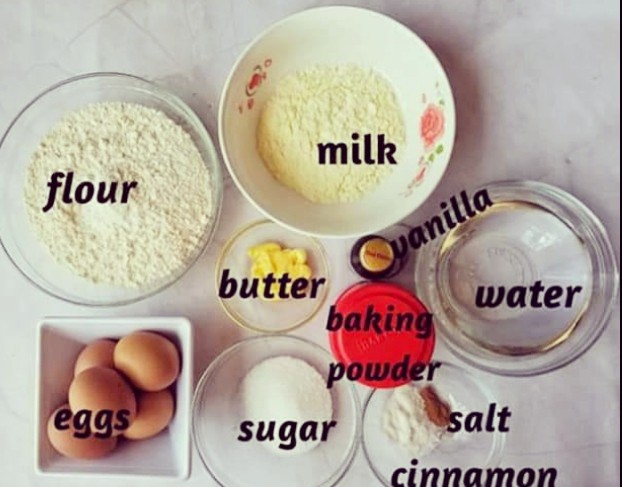
The following baking ingredients are the essential ingredients you need to have in your kitchen;
- Flour. Basic flour
- Leaveners. Eggs, Yeast, Baking Powder, Baking Soda
- Sugar. Syrup, Honey, White Sugar, Brown Sugar, Powdered Sugar
- Salt. Basic salt
- Dairy. Milk, butter
- Fats: Oil and Shortening. Oil, Butter, and Shortening
- Extracts and Flavorings like vanilla extracts, almond
- Add ins like chocolate, dried fruits, nuts
We have comprehensive details on the baking ingredients and their uses in a dedicated article. We have more insights on their prices and where to buy them. Go to Baking ingredients and their alternatives 2022.
Baking Methods
What are Baking methods?
Baking methods are those baking techniques used in realizing finished baked goods. There are four basic baking methods or procedures commonly used. We would mention them here and we will use one of the methods to whip up our perfect pound cake. The Four basic baking methods are the following:
Whisking Method
As the name implies, this whisking method requires a wet mixture to be whisked thoroughly and gently. This is done in order to incorporate air and body.
Eggs and sugar are whisked together before the dry ingredients are sieved very well and then folded gently through the egg mixture in batches, maybe in two or three. The batter must be folded until there are no traces of flour but must not be overmixed. Whisking method cakes are great too if people are looking to eat less fat, or are after a lighter sponge cake as they mostly contain no butter.
Melting Method
The butter or fat used in the cake is often melted together in a pot before the eggs and then the dry ingredients are added. There is no beating or whisking in this method to aerate the mix. That is why the final product is always moist and dense. A chemical raising agent such as baking powder is used to help the cake rise.
Rubbing Method
With this method, fat usually butter is first rubbed into flour using the fingertips. This will create a breadcrumb or sand-like texture. Then you put in the sugar followed by the liquid, like milk.
As soon as the liquid is incorporated, stop working the mix to avoid a tough end texture.
The rubbing-in method is used for crumble toppings, some pastries, and of course, scones
Creaming Method
I have deliberately kept this method on the last list. This is because I would work with a very basic pound cake as our test recipe for what we have learned so far using the Creaming Method.
Possibly the commonest of all the methods, the creaming method is the base of many baked goods, especially cakes and cookies. The method requires thorough creaming, or blending together, of butter and sugar before any other ingredient is added. During the creaming, it is important to keep going until the butter and sugar mix is pale, light, and creamy. The creaming method is the standard method used for making butter cakes and coffee cakes.
Let us now use the creaming method to whip up a perfect pound cake that would be awesome for everyone. Okay let’s go
How to bake a Pound cake
A pound cake is a type of cake traditionally made with a pound of each of four ingredients: flour, butter, eggs, and sugar.
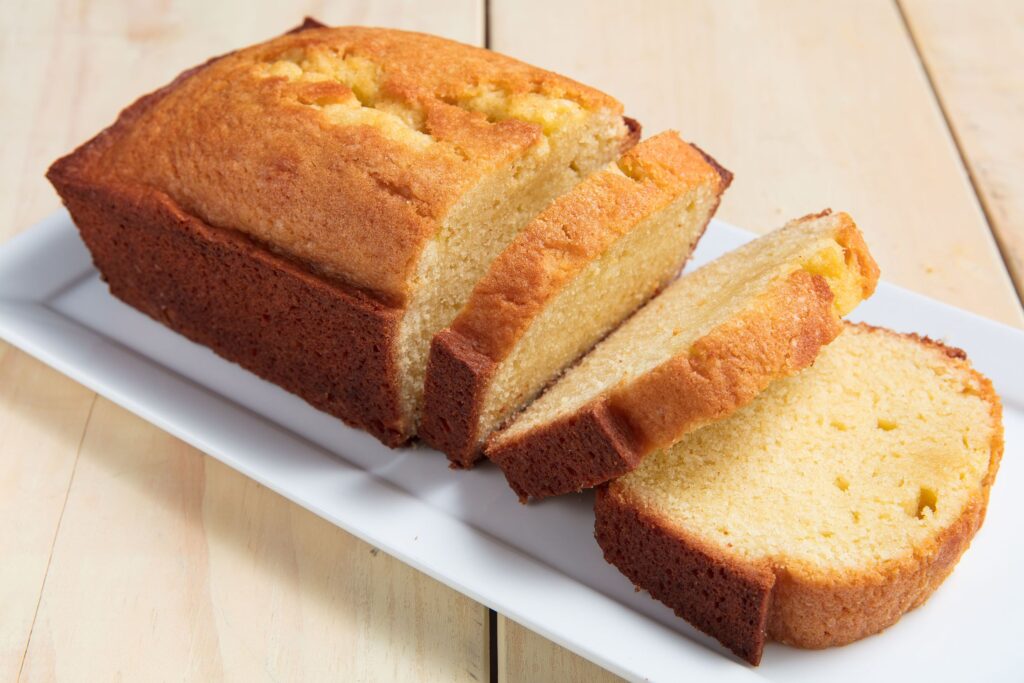
1. Prep your recipe and pre-heat the oven
3 ¼ cups white sugar
¾ pound unsalted butter, at room temperature
6 extra-large eggs, at room temperature
2 teaspoons pure vanilla extract
3 cups all-purpose flour
½ teaspoon baking powder
½ teaspoon salt
¼ teaspoon ground nutmeg
1 cup 1% milk
2. Cream your butter
Get your sugar and butter in a large mixing bowl. Cream together using an electric mixer fitted with a paddle attachment, or a hand mixer, on medium speed, until light and fluffy, about 5 minutes. Add eggs one at a time, beating for 45 seconds after each addition. Add vanilla extract and beat for 30 seconds.
3. Add other ingredients
Combine flour, baking powder, salt, and nutmeg in a medium bowl. Add 1/2 of the dry ingredients to the butter and egg mixture, mixing at low speed, until just blended. Add 1/2 cup milk and beat on low speed until just blended. Scrape the sides of the bowl with a spatula between each addition. Repeat with remaining dry ingredients and milk.
4. Pour dough into cake pan
Pour batter into the prepared baking pan, filling no more than 2/3 full. Smooth the top with a spoon or a spatula to get an even level. Ensure the cake pan had parchment paper or you can use flour to massage on it.
5. Bake Bake Bake!
Bake in the preheated oven. You know when your cake is done when a toothpick inserted into the center of the cake comes out clean and the cake is just starting to pull away from the sides of the pan. That would be about 1 hour and 25 minutes. Remove from the oven and allow to cool for about 15 minutes before inverting onto a plate. Allow cooling completely before eating your delicious dessert.

